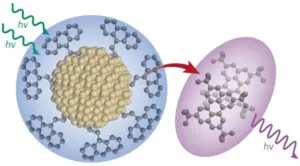Scientists from the University of Texas at Austin, the University of California Riverside, the University of Colorado Boulder, and the University of Utah have combined ultra-small silicon nanoparticles with organic molecules, materials similar to those used in OLED TVs. The research hints at potential benefits for numerous light-driven technologies. Although the research is in its nascent stages, the outcomes indicate promising advancements for light-driven applications.

At the core of this innovation is the hybrid material’s ability to transmute long-wavelength photons – common in red light and adept at permeating tissue, fog, and liquids – into short-wavelength blue or ultraviolet photons. The latter category of photons is typically responsible for triggering a wide variety of chemical reactions, making them integral to the functioning of many light-driven applications.
The researchers’ approach of establishing conductive bridges between anthracene, an organic molecule, and silicon nanocrystals is unique. This strong chemical bond fosters a rapid exchange of energy between the two molecules, leading to an almost twofold improvement in efficiency when converting lower-energy light to higher-energy light, as compared to previous methods.
This hybrid material could unlock a new level of potential for applications that leverage light, such as bioimaging, 3D printing, solar cells, and sensors. The ability to use near-infrared light could drastically improve the efficiency and functionality of these applications, making them more accurate and reliable.
Reference
Wang, K., Cline, R.P., Schwan, J. et al. Efficient photon upconversion enabled by strong coupling between silicon quantum dots and anthracene. Nat. Chem. (2023). https://doi.org/10.1038/s41557-023-01225-x

